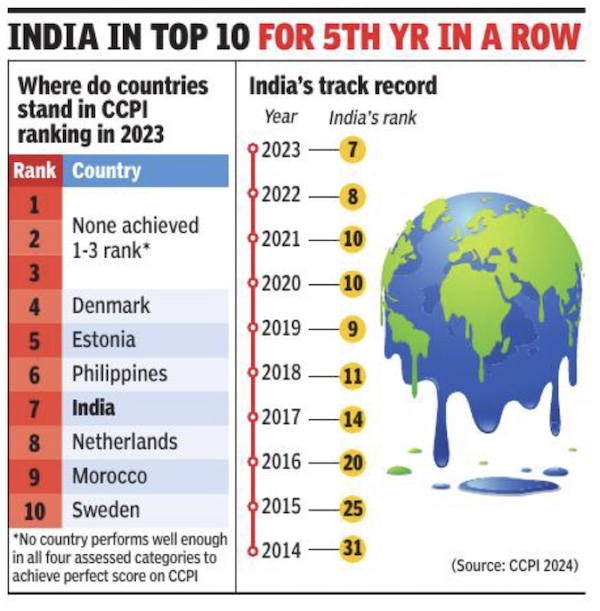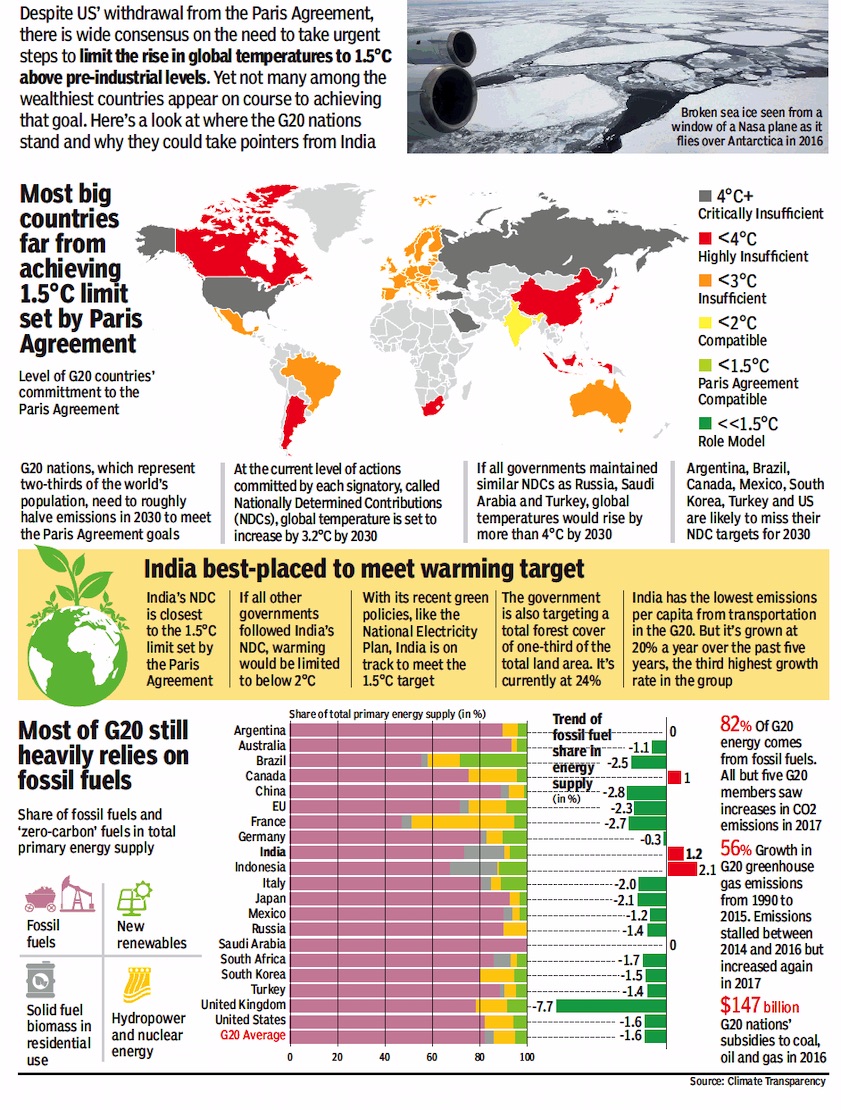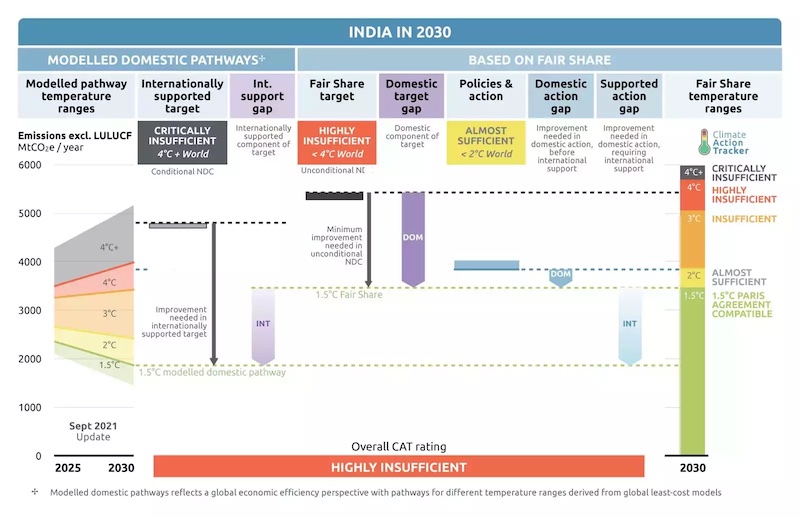Climate change action: India
This is a collection of articles archived for the excellence of their content. |
Contents |
Cities
As in 2019, 20
Dipak Dash, June 27, 2021: The Times of India

From: Dipak Dash, June 27, 2021: The Times of India
Indian cities are becoming more climate conscious while planning and implementing projects, shows a comparative assessment done by the urban affairs ministry. Though none of the 126 cities assessed could get the 5-star rating, the number of cities improving their ratings in the past two years has increased significantly.
According to the “Climate Smart Cities Assessment Framework 2.0” (CSCAF 2.0) report released on Friday, only nine cities could get 4-Star rating and no city from North India could make it to this list. The nine cities are: Surat, Indore, Ahmedabad, Pune, Vijayawada, Rajkot, Visakhapatnam, Pimpri-Chinchwad and Vadodara.
The cities were ranked on five parameters of urban planning; green cover and biodiversity; energy and green buildings; mobility and air quality; and water management and waste management.
While in 2019, only four cities had got 4-star rating, last year the number increased to nine and the number of cities with 3-star rating increased from only four to 22. Similarly, the number of cities with 2- star rating increased from 25 in 2019 to 64 last year. The number of cities with the lowest 1-star rating fell from 66 to 33.
The report has put cities under “one Star” if they are in the early stages of development and yet to consider climate change or are in the process of conceptualising climate actions. “Four star” cities are those which have allocated budgets and initiated implementation of projects.
It said significant progress has been reported specifically in the themes of urban planning, green cover and biodiversity; energy and green buildings; and waste management.
According to the report, 10 of the126 cities are meeting over 15% of their electricity needs from renewable sources while 44 cities have initiated flood and water stagnation risk assessment. It said 44 cities have instituted the mechanism for processing 100% of collected wet waste and 87 cities have some form of air quality monitoring stations. About 35 cities have developed clean air action plans. It said no city could get 5-star in water management and mobility and air quality category.A maximum of 31cities got 5-star in waste management.
Climate Change Performance Index and India
2019: India no.9
Vishwa Mohan, Dec 11, 2019 Times of India
India for the first time ranks among the top ten countries in the Climate Change Performance Index (CCPI) which is being released annually after analysing four parameters— greenhouse gas (GHG) emissions, renewable energy, climate policy and energy use. The country has, in fact, improved its ranking from 11th last year to ninth this year.
The first three spots in the CCPI were, however, left vacant symbolically as none of the countries assessed is on a trajectory compatible with the Paris Agreement, signed in 2015.
The top three performers are Sweden (fourth), Denmark (fifth) and Morocco (sixth). The CCPI is a ranking of 57 countries and the European Union (EU), is collectively responsible for about 90% of the global GHG emissions. The CCPI 2020, released by three international NGOs — Germanwatch, New Climate
Institute and Climate Action Network — on the sidelines of the ongoing UN climate change conference (COP25) on Tuesday, shows that the EU collectively (22nd) and China (30th) rank below India in the list whereas the second largest global emitter, the USA, figure at the bottom.
The CCPI report noted that the current levels of per capita emissions and energy use are still comparatively low in the country. . “While the country receives an overall medium rating in the renewable energy category, India’s 2030 renewable energy target is rated very high for its well-below-2°C compatibility,” said the report.
It added, “Despite an overall high rating for its ‘Climate Policy’ performance, experts point out that the government has yet to develop a roadmap for the phase-out of fossil fuel subsidies that would consequently reduce the country’s high dependence on coal.”
Besides the USA, some other countries in the ‘very low’ rating category in the CCPI are Turkey, Poland, Japan, Russia, Canada and Australia. However, on the positive side, 31 of the 57 high emitting countries are showing falling emission trends.
“The new Climate Change Performance Index shows signs of a global turnaround in emissions,” said Ursula Hagen of the Germanwatch.
2020
Vishwa Mohan, December 8, 2019: The Times of India

From: Vishwa Mohan, December 8, 2019: The Times of India
India remains in the top 10 for the second year in a row in the latest global Climate Change Performance Index (CCPI) released in Germany on Monday. The biggest current emitter of greenhouse gases (GHG) China figures at 33rd rank while the largest historical polluter, the USA, appears at the bottom of the list.
Though India slid one position down from ninth in 2019 to 10th this year, the country’s journey towards climate protection has been consistent with it improving its ranking from 31st in 2014.
Globally none of the countries assessed for the annual CCPI report are, however, on the path to meet their Paris Agreement commitment of keeping global warming increase below 2 degree celsius by the end of the century and actually to make efforts to restrict it to 1.5 degree celsius rise.
The list is prepared by assessing performances of 57 countries and the EU (as a whole) in four categories —GHG emissions (40%), renewable energy (20%), energy use (20%) and climate policy (20%). These 57 countries and the EU collectively are responsible for about 90% of global GHG emissions.
The CCPI is developed by not-for-profit organisations Germanwatch and NewClimate Institute (Germany) together with the Climate Action Network (CAN International). The CCPI 2021, covering the year 2020, shows that only two G20 countries — the UK and India — are among the high rankers while six others — the USA, Saudi Arabia, Canada, Australia, South Korea and Russia (52nd ) — are at the bottom of the index. It’s the second time in a row that the USA is bringing up the rear, below Saudi Arabia.
The report, covering CCPI, shows that overall, GHG emissions have increased slightly, but are actually falling in more than half of the countries (32) surveyed.
2014-23

From: Dec 9, 2023: The Times of India
See graphic:
Where do countries stand in CCPI ranking in 2023; India's track record, 2014-23
Initiatives, by Government
Mission LiFE
Mahesh Langa, Oct 20, 2022: The Hindu
Prime Minister Narendra Modi, in the presence of U.N. Secretary-General Antonio Guterres, launched ‘Mission LiFE’ (Lifestyle For Environment), a new initiative for sustainable and healthy lifestyle at the Statue of Unity in Gujarat.
Listing climate change and global warming as the main challenges before the world and mankind, the Prime Minister underlined that Mission LiFE makes the fight against climate change democratic with the contribution of everyone in per own capacity.
Mr. Guterres unveiled the LiFE logo and tagline and released the Mission Document at the event in which the Union Minister of External Affair Dr S. Jaishankar and Gujarat Chief Minister Bhupendra Patel were also present.
“The launch of Mission LiFE in Gujarat is important as it was the first state in the country to initiate measures in the direction of renewable energy and climate protection,” PM Modi said, adding that measures like solar power plants or installing panels on canals or water conservation in drought-prone were meant to flight the environmental related calamities while setting the trends for sustainable development.
PM Modi described the Mission LiFe as a global initiative by India to help the world in its fight against climate change and lead to a sustainable way of life to achieve the sustainable development goals set by the U.N..
He said the Mission LiFE emboldens the spirit of the P3 model, i.e. Pro Planet People, as it is premised on the basic principles of ‘Lifestyle of the planet, for the planet and by the planet’.
According to him, India and the UN have joined hands in this new initiative which will become a global success. “India had proposed the International Day of Yoga, which was supported by the UN. Today it is inspiring millions of people around the world to lead a healthy life.”
He stressed that the fight against climate change goes beyond policy making and it needs wider support from individuals to the family community to protect the environment, and earth and help each other against climate-related disasters and extreme weather calamities.
Mr. Modi advocated a circular economy where the concept of ‘Reduce, Reuse and Recycle’ can help in striking a balance between the development, economic growth and sustainability.
“Such practices are prevalent, which inspire us to walk in harmony with nature. Mission LiFE will encompass every lifestyle related to the conservation of nature, which our ancestors adopted, and that can be made a part of our lifestyle today,” said PM Modi.
In his speech, he talked about India’s commitment to tackling the menace of climate change with an emphasis on renewable energy like wind and solar.
According to him, the annual per capita carbon footprint in the country is only about 1.5 tons, compared to the world average of 4 tons per year while India has the fourth largest capacity for renewable energy in the world.
“India is ranked fourth in wind energy and fifth in solar energy. India’s renewable energy capacity has increased by about 290 % in the last 7-8 years. The country has also achieved the target of 40% of the electric capacity from non-fossil-fuel sources nine years ahead of the deadline.”
Through the National Hydrogen Mission, India has moved towards an environment-friendly energy source. This will help India and many countries of the world to achieve their goal of net zero carbon footprint.
During the event, Prime Minister Modi also attended a bilateral meeting with U.N. Secretary-General, Antonio Guterres, who handsomely praised India’s initiatives towards sustainable development.
In his speech, the U.N. Secretary-General said that the “Lifestyle For Environment (LiFE) initiative is designed to highlight essential and hopeful truths.”
Mr. Guterres lauded India’s initiative of the International Solar Alliance and said that the country was pursuing environmentally sound policies to promote renewable energy and reducing usage of fossil fuels.
“We need to unleash the renewable revolution and I look forward to working with India in driving this agenda forward,” Mr. Guterres added. During his trip to Gujarat, Mr. Guterres also visited Modhera Sun Temple near Ahmedabad where the entire village draws the power from solar panels installed in the temple campus as well as on the rooftops of the houses and the government offices.
More than 500 people consisting of 116 Indian Heads of Missions abroad, U.N. Heads of Agencies in India, top government officials, development partners, and other policy makers.
The vent was jointly organised by NITI Aayog, the Ministry of Environment and Forest and Climate Change in collaboration with Government of Gujarat. ]
Paris Agreement

The share of fossil fuels and zero carbon fuels in the primary energy supply of India and other major countries
From: November 27, 2018: The Times of India
See graphic:
The compliance of India and other major countries with the Paris Agreement, presumably as in 2017.
The share of fossil fuels and zero carbon fuels in the primary energy supply of India and other major countries
2021: rating system downgrades India on climate action
Vishwa Mohan, Sep 16, 2021: The Times of India
From: Vishwa Mohan, Sep 16, 2021: The Times of India

From: Vishwa Mohan, Sep 16, 2021: The Times of India
NEW DELHI: India may be the only G20 country and among few countries globally that have been ‘2 Degree Celsius’ temperature rise compatible under the Paris Agreement, but a new stringent rating system of the Climate Action Tracker (CAT) has downgraded the country's overall rating from ‘almost sufficient’ category in November last year to ‘highly insufficient’ category at par with China, Australia, New Zealand, Brazil, Canada, South Korea, Argentina and Mexico this month.
The new rating system factored in different parameters including updates on climate action targets such as mid-century ‘net zero’ emission goal and ‘1.5 Degree C’ compatibility measures.
The rating of 37 countries by the CAT, run by Germany-based non-profit group Climate Analytics and research body New Climate Institute, shows small nation Gambia as the only country which is ‘1.5 degree C’ compatible.
The CAT has rated UK, Germany, Japan, USA, Nepal and 12 other countries above India in either ‘almost sufficient’ and ‘insufficient’ categories due to upgradation of their respective climate action goals and other measures. Though the UK’s domestic target is ‘1.5 degree C’ compatible, the Tacker noted that the country’s policies and international support don’t match.
India’s rating will, however, improve significantly if it upgrades its climate action target – called nationally determined contribution (NDC) – under Paris Agreement, factoring in its decision to set up 450 GW of renewable energy by 2030. The country’s clean energy push through renewables and green hydrogen will, in fact, make it ‘1.5 degree C’ compatible.
“In the previous system, we had only rated India’s NDC target against its fair share. We have updated our fair share calculations, and for India these have become more stringent, leading to a fair share rating of ‘highly insufficient’, compared to its previously ‘2 degree C compatible’ (almost sufficient),” said the Tracker in its global update on climate action.
“Of particular concern are Australia, Brazil, Indonesia, Mexico, New Zealand, Russia, Singapore, Switzerland and Vietnam. They have failed to lift ambition at all, submitting the same or even less ambitious 2030 targets than those they put forward in 2015. These countries need to rethink their choice,” said Bill Hare, CEO of Climate Analytics.
On the policy front, the Tracker noted that coal remains an issue with China and India both having huge plans in the pipelines. “South East Asia is also of concern, with Indonesia, Vietnam, Japan and South Korea still planning to forge ahead with the most polluting of fossil fuels,” said the CAT’s report.
On NDC, it said the updates submitted so far in 2020–2021 have narrowed the gap to what is needed for 1.5 degree C only by up to 15%. There are still over 70 countries that have yet to submit an updated target.
On ‘net zero’ push, the report said though the wave of national mid-century ‘net zero’ targets give reasons for hope, it will fail without sufficient 2030 reductions. “There needs to be alignment between 2030 targets and net zero goals for the latter to be believable. Our assessment shows that most net zero targets are formulated vaguely and do not yet conform with good practice,” it said.